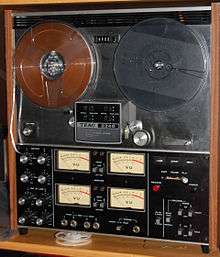TEAC Corporation
.svg.png) | |
Native name | ティアック株式会社 |
|---|---|
| Public KK | |
| Traded as | TYO: 6803 |
| Industry | Electronics |
| Founded | Tokyo, Japan (August 29, 1953) |
| Headquarters | Ochiai, Tama-shi, Tokyo, 206-8530, Japan |
Key people |
Yuji Hanabusa (President) |
| Products |
|
| Revenue | (US$ 185 million) (FY 2014) |
|
JPY -1.8 billion (FY 2014) (US$ -16.6 million) (FY 2014) | |
Number of employees | 1,046 (consolidated, as of September 30, 2015) |
| Parent | Gibson Brands, Inc. (54.42%)[1] |
| Website | Official website |
|
Footnotes / references [2][3] | |
TEAC Corporation (ティアック株式会社 Tiakku Kabushiki-gaisha) (pronounced "Tee-ack") is an electronics company based in Japan. TEAC was founded in 1953 as the Tokyo Electro Acoustic Company.[4]
Overview


TEAC has four divisions:
- TASCAM - consumer to professional audio products, mostly recording
- ESOTERIC - High-end consumer audio products
- TEAC Consumer Electronics - Mass market audio products
- Data Storage and Disk Publishing Products - Floppy drives, DVD and CD recorders and drives, MP3 players & NAS storage
TEAC is known for its audio equipment, and was a primary manufacturer of high-end audio equipment in the 1970s and 1980s. During that time, TEAC produced notable reel-to-reels, cassette decks, CD players, turntables and amplifiers.
Of particular note is that TEAC produced an audio cassette with tape hubs that resembled reel-to-reel tape reels in appearance. Many manufacturers at the time used these TEAC cassettes in advertisements of their tape decks because the TEAC cassettes looked more professional than standard audio cassettes, and because reel-to-reel tape recordings were known to be of higher quality than cassette recordings.
In the 80s and 90s TEAC became well known for producing inexpensive high quality floppy disk drives. Up until the mid 90s floppy drive quality was inconsistent, often resulting in a disk that could be read only with the drive that wrote it due to minor variances in manufacturing specifications. TEAC became a leader in high quality floppy drives during this time.
History
The company that eventually became the TEAC corporation was founded in August 1953. Originally named the Tokyo Television Acoustic Company,[4] it employed Katsuma Tani, a former aviation and aeronautics engineer,[5] who established a reputation as a highly qualified creator of audio equipment.
In 1956 his brother, Tomoma Tani, brought home a hand-made, 3-motor, 3-head stereo tape recorder. This sparked Katsuma's interest in reel-to-reel tape recorders. Confident they could engineer a better tape recorder, the Tani brothers founded the Tokyo Electro-Acoustic Company on December 24, 1956.[6]
The Tokyo Television Acoustic Company and the Tokyo Electro-Acoustic Company were merged to create the TEAC corporation. The main focus of the new company was to design and manufacture tape recorders.[4]
In 2013 Gibson Brands Inc. bought a majority stake in the company.[7]
Computer tape memory systems
In May 1961 TEAC entered into a licensing agreement with IBM to create magnetic tape memory systems.
References
- ↑ "Company Profile". 4-traders.com. Surperformance SAS. Retrieved March 11, 2016.
- ↑ "Corporate Profile". TEAC Corporation. Retrieved March 11, 2016.
- ↑ "Company Profile". Nikkei Asian Review. Nikkei Inc. Retrieved March 11, 2016.
- 1 2 3 "TEAC Milestones". TEAC Audio Europe. TEAC Corporation. Retrieved March 11, 2016.
- ↑ "TEAC Corporation - Company Profile, Information, Business Description, History". ReferenceforBusiness.com. Advameg, Inc. Retrieved March 11, 2016.
- ↑ Alberts, Randy (2003). TASCAM: 30 Years of Recording Evolution. Hal Leonard Corporation. p. 15. ISBN 978-0-634-01156-6.
- ↑ "Gibson Guitar to buy TEAC, add "Cool Japan" engineering technology". Reuters. Thomson Reuters. March 29, 2013. Retrieved March 11, 2016.
External links
- TEAC Worldwide (English)
- TEAC North America (English)